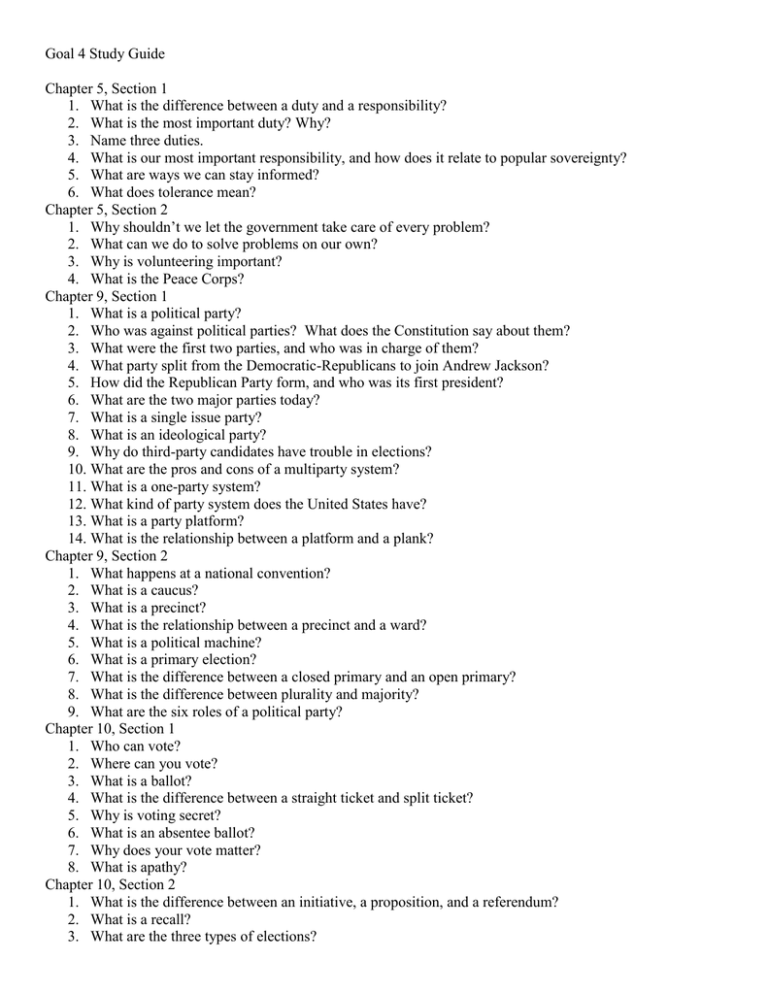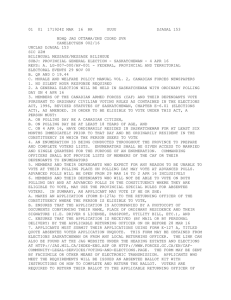Goal 4 Study Guide Chapter 5, Section 1
advertisement

Goal 4 Study Guide Chapter 5, Section 1 1. What is the difference between a duty and a responsibility? 2. What is the most important duty? Why? 3. Name three duties. 4. What is our most important responsibility, and how does it relate to popular sovereignty? 5. What are ways we can stay informed? 6. What does tolerance mean? Chapter 5, Section 2 1. Why shouldn’t we let the government take care of every problem? 2. What can we do to solve problems on our own? 3. Why is volunteering important? 4. What is the Peace Corps? Chapter 9, Section 1 1. What is a political party? 2. Who was against political parties? What does the Constitution say about them? 3. What were the first two parties, and who was in charge of them? 4. What party split from the Democratic-Republicans to join Andrew Jackson? 5. How did the Republican Party form, and who was its first president? 6. What are the two major parties today? 7. What is a single issue party? 8. What is an ideological party? 9. Why do third-party candidates have trouble in elections? 10. What are the pros and cons of a multiparty system? 11. What is a one-party system? 12. What kind of party system does the United States have? 13. What is a party platform? 14. What is the relationship between a platform and a plank? Chapter 9, Section 2 1. What happens at a national convention? 2. What is a caucus? 3. What is a precinct? 4. What is the relationship between a precinct and a ward? 5. What is a political machine? 6. What is a primary election? 7. What is the difference between a closed primary and an open primary? 8. What is the difference between plurality and majority? 9. What are the six roles of a political party? Chapter 10, Section 1 1. Who can vote? 2. Where can you vote? 3. What is a ballot? 4. What is the difference between a straight ticket and split ticket? 5. Why is voting secret? 6. What is an absentee ballot? 7. Why does your vote matter? 8. What is apathy? Chapter 10, Section 2 1. What is the difference between an initiative, a proposition, and a referendum? 2. What is a recall? 3. What are the three types of elections? 4. Who makes up the Electoral College? Chapter 10, Section 3 1. What is the maximum amount of money an individual can contribute to a political campaign? What about a PAC? 2. What is a PAC? 3. What is soft money? 4. What is an incumbent? 5. What are the sources of funds for political campaigns? Chapter 11, Section 1 1. What is the biggest influence on public opinion? 2. What are three other influences on public opinion? 3. What are the three features of public opinion? 4. How is public opinion measured? What do you call the person that conducts polls? 5. Why is it important to have random samples? 6. What is a push poll, and why is it not reliable? 7. What are the pros and cons of polls? Chapter 11, Section 2 1. What are the two types of media? 2. Why would the relationship between media and politicians be called “love/hate”? 3. What is a leak? 4. How is the media a watchdog? 5. What is prior restraint? 6. What is censorship? Chapter 11, Section 3 1. What is a lobbyist? 2. What are the pros and cons of interest groups? 3. List the seven types of propaganda, and give an example of each. VOCABULARY 1. duty2. responsibility3. tolerance4. bureaucracy5. welfare6. political party7. two-party system8. third party9. platform10. plank11. national committee12. political machine13. direct primary14. closed primary15. open primary16. plurality17. majority18. polling place19. precinct20. ballot21. absentee ballot22. exit poll-




